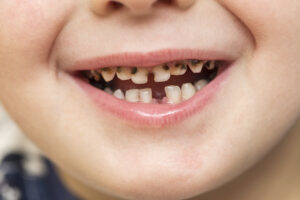Tooth pain can disrupt even the simplest of activities for children, from enjoying their favorite foods to concentrating on schoolwork or playtime. The discomfort demands attention, often indicating an underlying dental problem. Therefore, parents and caregivers need to grasp the primary causes of tooth pain in children to effectively manage it and prevent further complications.
5 Top Causes of Tooth Pain in Kids
Dental Decay
Many people, especially children, experience tooth pain as a result of dental decay, also known as cavities. It initiates its silent assault as plaque, a sticky amalgam of bacteria, accumulates on teeth, secreting acids that gradually corrode the enamel—the protective shield encasing teeth. As this erosion progresses, cavities form, exposing the sensitive inner layers of the tooth and triggering discomfort.
Various factors contribute to the onset of dental decay, including:
- Poor Oral Hygiene: Neglecting to brush and floss regularly allows plaque to thrive, accelerating enamel erosion.
- Dietary Habits: Excessive consumption of sugary and acidic foods fuels the bacteria’s acid production, hastening decay.
- Infrequent Dental Check-ups: Skipping routine dental visits prevents early detection and intervention against cavities, allowing them to advance unchecked.
The symptoms of tooth pain linked to dental decay manifest subtly but unmistakably, including:
- Sensitivity to hot or cold temperatures signals enamel erosion and exposure of the tooth’s inner layers.
- Sharp pain upon biting down, indicative of cavity formation compromising tooth structure.
- Persistent toothache, a telltale sign of advanced decay and potential infection.
If your child has any of these signs, they need to see a dentist right away to stop the damage from getting worse and ease their pain. Preventing dental decay hinges on adopting and adhering to sound oral hygiene practices, such as:
- Help your child brush twice daily with fluoride toothpaste and floss daily to keep their teeth strong.
- Limit sugary and acidic foods to protect their teeth.
- Schedule regular dental check-ups to catch any issues early.
Gum Disease
Gum disease, or periodontal disease, often lurks beneath the surface, quietly causing tooth pain that can easily be overlooked. It all starts innocently with the inflammation of the gums, known as gingivitis. However, if left untreated, this seemingly minor irritation can evolve into a more severe condition called periodontitis.
Plaque, a sticky film of bacteria, is the main cause of gum disease in kids. If not brushed away regularly, plaque hardens into tartar, leading to irritated and inflamed gums. Over time, this can cause gums to pull away from the teeth, creating pockets where harmful bacteria thrive and cause more damage.
Symptoms of tooth pain stemming from gum disease are subtle yet significant, including:
- Swollen or puffy gums
- Tender or sensitive gums
- Gums that bleed easily, especially during brushing or flossing
- Persistent bad breath or a bad taste in the mouth
- Receding gums, making teeth appear longer than usual
Tooth Abscess
A tooth abscess is a serious dental issue that results from bacterial infection and the formation of a pus-filled pocket. This infection can manifest either within the tooth (periapical abscess) or in the surrounding gum tissue (periodontal abscess).
In kids, a tooth abscess usually stems from severe dental decay that reaches deep into the tooth’s core, called the pulp. Bacteria sneak into this inner part through a cavity or crack, quickly multiplying and causing the body to react with inflammation. This leads to intense pain and swelling as pus builds up in the affected area.
Signs and symptoms of a tooth abscess are unmistakable, including:
- Severe, Throbbing Toothache: A persistent, intense pain that can radiate to the jaw, ear, or neck.
- Swelling of the Face or Gums: Visible inflammation or puffiness around the affected tooth or throughout the face.
- Fever: Elevated body temperature, indicative of systemic infection.
- Foul Taste or Odor in the Mouth: A distinctive, unpleasant taste or smell stemming from the infected area.
Not taking care of a tooth abscess can cause serious problems, like the infection spreading to other parts of the mouth or forming a dental fistula—a tiny tunnel where pus comes out.
To treat a tooth abscess, the dentist will:
- Drain the Pus: To make the pain go away, they’ll get rid of the pus from the abscess.
- Remove the Infection: This might mean doing a root canal to take out the infected part of the tooth and seal it, or pulling out the tooth if it’s too damaged.
- Give Antibiotics: These are special medicines that help fight the infection and stop it from coming back.
Tooth Sensitivity

Several factors can contribute to tooth sensitivity, including:
- Enamel erosion: Acidic foods and beverages, as well as aggressive brushing techniques, can wear down the enamel over time, exposing the dentin and increasing sensitivity.
- Gum recession: Receding gums can expose the teeth’s roots, which are less protected by enamel and more prone to sensitivity.
- Dental procedures: Certain dental treatments, such as teeth whitening or dental cleanings, can temporarily increase tooth sensitivity.
- Cracked teeth: Fractures or cracks in the teeth can expose the dentin and lead to sensitivity, especially when chewing or biting down.
Symptoms of tooth sensitivity may include sharp, sudden pain when consuming hot, cold, sweet, or acidic foods and beverages. Individuals with sensitive teeth may also experience discomfort when brushing or flossing.
Managing tooth sensitivity involves taking steps to reduce exposure to triggers and strengthen the enamel to minimize sensitivity. Some strategies to alleviate tooth sensitivity include:
- Using desensitizing toothpaste: Specialized toothpaste containing ingredients like potassium nitrate or fluoride can help block pain signals from reaching the nerves in the teeth.
- Avoiding acidic foods and beverages: Limiting consumption of acidic foods and drinks, such as citrus fruits and soda, can help prevent further enamel erosion and reduce sensitivity.
- Practicing proper oral hygiene: Gentle brushing with a soft-bristled toothbrush and flossing regularly can help maintain oral health and prevent gum recession, reducing sensitivity.
- Applying fluoride treatments: Professional fluoride treatments or at-home fluoride rinses can help strengthen enamel and reduce sensitivity.
Tooth Fractures
Tooth fractures, which happen when a tooth breaks, can cause different levels of pain—from a little bit to a lot. They can happen for lots of reasons, like accidents, playing sports, or biting down on something hard.
Different types of tooth fractures can happen, each with its signs and treatments. Small cracks on the surface of the tooth, called craze lines, usually don’t hurt and might not need fixing. But if a fracture goes deeper into the tooth, it can hurt a lot and might need special treatment.
Symptoms indicative of a tooth fracture encompass:
- Sharp Pain When Biting Down: A sudden, sharp pain upon applying pressure while chewing or biting.
- Sensitivity to Hot or Cold Temperatures: Heightened sensitivity to temperature extremes, often manifesting as discomfort or pain.
- Intermittent Discomfort Worsening Over Time: Recurrent episodes of discomfort that intensify with time, indicating progressive damage.
- Visible Chipping or Cracking: Observable damage to the tooth’s surface manifests as visible chips or cracks.
- Radiographic Evidence: Identification of fractures through dental X-rays, particularly when damage isn’t apparent externally.



